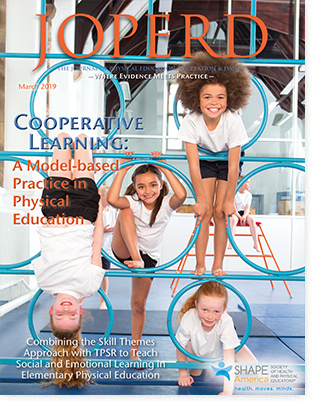 JOPERD Table of Contents
JOPERD Table of Contents
Combining the Skill Themes Approach with TPSR to Teach Social and Emotional Learning
K. Andrew R. Richards, Victoria Nicole Ivy, Paul M. Wright, and Emily Jerris

Building largely from the seminal work of Don Hellison (1973, 1978, 1986), the teaching personal and social responsibility (TPSR; Hellison, 2011) model has become recognized as a best-practice pedagogical model for integrating the principles of sport-based youth development and affective learning into physical education (Metzler, 2011; Richards, Ivy, Lawson, & Alameda-Lawson, 2018). The TPSR model is a humanistic, developmental and student-centered approach to teaching physical education that seeks to build on students’ enjoyment of physical activity to initiate discussions about personally and socially responsible behavior both inside and outside of the gymnasium (Gordon & Doyle, 2015). Importantly, the focus on responsibility instruction is pursued concurrent with, rather than in the place of, physical activity and motor skill–development goals (Hellison, 2011).
While TPSR programming and research have expanded over the past few decades in both in-school physical education and out-of-school physical activity contexts (Jacobs, Lawson, Ivy, & Richards, 2017; Pozo, Grao-Cruces, & Pérez-Ordás, 2018), most of this work has focused on applications in secondary school environments. Fewer scholars and practitioners have described or studied personal and social responsibility instruction with elementary school-age children. The authors view this as a limitation to the further development of the TPSR model. Similar to sport skills commonly taught in physical education and activity contexts, there are benefits to teaching the social and emotional learning competencies emphasized through the TPSR model (e.g., responsible decision making, relationship skills, social awareness, self-awareness, self-management and goal setting; Schonert-Reichl, Kitil, & Hason-Peterson, 2017) from an early age (Ashdown & Bernard, 2012). Further, when social and emotional learning competencies are taught in elementary school, they can be developed into learning progressions as youth move from elementary into secondary school environments.
To read the rest of this article, click here to download a pdf.